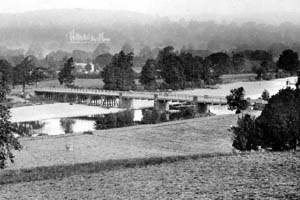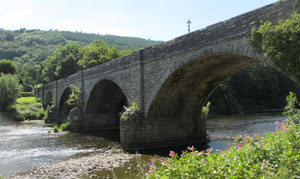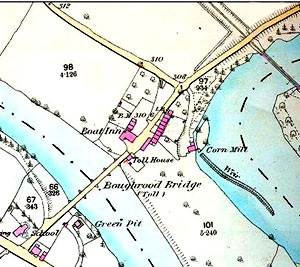|
The Bridges and their Historical Context |
|
Bridges, Fords and Ferries
Forded crossing points across major rivers were important in the siting and development of early riverside settlements and had been used at Glasbury, Boughrood and Hay, possibly till the late 19th / early 20th century when bridge-building techniques were able to cope with the destructive power of the more serious floods. Prior to this the existing bridges were often partially destroyed or sometimes swept away altogether, when fords would again be brought back into common use. The ferries also pre-dated the major bridges and often ran by the forded crossings, being used to ferry both people and goods. They were also invaluable at higher water levels when the fords would be impassable to people and livestock. They could also be an exciting and sometimes hazardous experience for the passengers concerned. Glasbury Bridge There was a timber bridge which fell in 1738 and this was replaced
by another timber bridge, both probably being near the Abbots
ferry. This one lasted about 40 years before being replaced by
a fine seven arched stone bridge in 1777. The bridge was built
by Thomas Edwards ( sometimes landlord of the Three Cocks Inn
) under the direction of William Edwards , his father, who had
built ' the great bridge on the Taff ' ( the old bridge at Pontypridd
). In 1850 the wooden bridge was damaged rendering it useful for
foot passengers only and the ferry was brought back into regular
usage. After a celebrated legal dispute (
click here for details ) a replacement bridge was constructed,
with stone piers on the Breconshire side and wooden supports,
largely untouched, on the Radnorshire or northern side, with relative
costs being an important consideration for this unusual compromise.
The bridge cost Brecon £2000 whereas the increase in rateable
value was only £470, ( presumably from the part of Glasbury
deemed to be in Brecon ? ) Boughrood Bridge
The Boughrood Bridge was built in 1838 - 42 by the de Wintons
of the Maesllwch Estate to carry coal, coke, lime and other goods
into southern Radnorshire. It replaced the earlier ford and the
ferry and was a substantial stone bridge with four segmental arches,
with semi-circular arches at the approach. A two storey toll house
was added to the northern end in 1843 and the occupants in 1850
combined the collection of tolls with a cobbling business - it
was common practice for the toll-people to have a secondary source
of income, especially so if they were supporting a large family.
In 1875 it was run by James Portnell. B Bowker Sources
: --
David
Pike - for confirmation on the seven arched bridge at Glasbury
|
|





